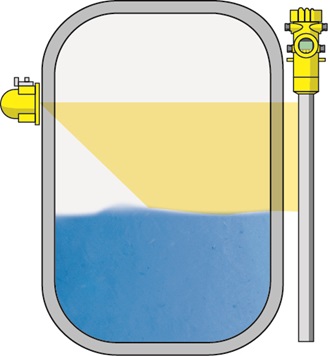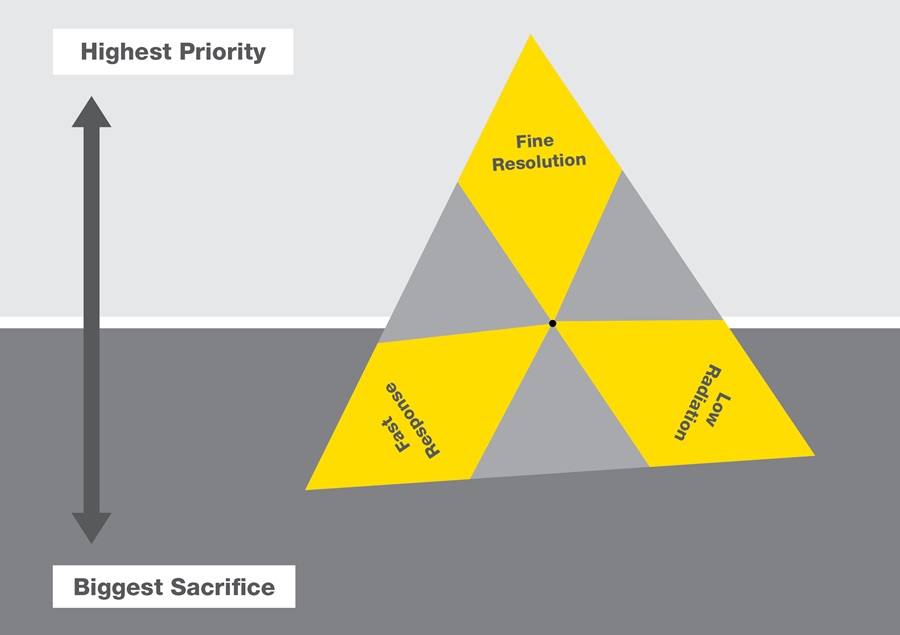The three R’s of radiometric measurements
The process automation industry has been using radiometric technology to make measurements for well over half a century now. Radiometric instrumentation can be used to measure continuous level, point level, density, and even mass flow. The technology is used to make these measurements in the world’s most challenging applications where process pressure, temperature, or conditions are too extreme for other measurement sensors. That’s because, unlike many other technologies, radiometric measurements can be made completely external of the process.
Despite its longevity and prominence, much is still misunderstood when it comes to radiometric instrumentation setup and calibration. This paper will explain the meanings of resolution, response time, and radioactivity and the relationship between these three criteria relative to radiometric measurements, clarifying how changing one can affect the other.
How radiometric sensors operate
To better understand the relationship between resolution, response time, and radioactivity, a basic comprehension of how radiometric measurements work is needed. Radiometric sensors come in two parts: a low-intensity isotope, also called a source, installed opposite a detector. The source holder collimates the gamma energy, so it’s directed only at the detector, which converts the gamma radiation into pulses of light using a scintillating element. The photomultiplier within the detector’s electronics records the number of pulses of light, known as the count rate. Because of the non-uniform nature of radioactive decay, the electronics within keep a running average count rate, which is used to infer a measurement and output a value.
Radiometric applications engineers look at vessel construction details, including the size of the vessel, vessel wall thickness, and the span of the measurement. This information alone will be used to provide multiple solutions of varying resolution, response time, and radioactivity. End users will need to determine which of these factors is most important to them in order to select a final solution.
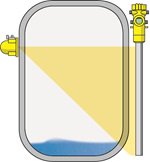
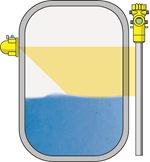
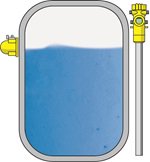
Resolution: How clear is your picture
Similar to the resolution of a photograph or video, the resolution of a radiometric measurement is how well an operator can “see” inside a vessel or pipe. The resolution is the degree of accuracy, and it can vary depending on the measurement requirements. Each application doesn’t require the same resolution. It may be important for some applications to know the exact level within an inch up and down the entire vessel, but for others, operators may only need to know the level in the top 25% of the vessel with an accuracy of a foot. Increasing the accuracy means either an increase in response time or radioactivity or both.
Response time: How quickly do you need the measurement
Radiometric measurements use a running average of the count rate to provide a stable, more accurate measurement. The amount of time used to calculate the running average is the response time. Without this, even an unchanging measurement would appear to bounce up and down every second due to the non-uniform nature of the radiation field. Averaging the counts over 30 seconds, 60 seconds, or even 120 seconds smooths the measurement out, but it also causes a slight delay between the change in process and detector response . Shortening the response time for a faster measurement would require either a decrease in the resolution of the measurement or an increase in the radioactivity.
Radioactivity: The “R” that makes it radiometric
Most radiometric measurement instrumentation uses one of two isotopes: cesium 137 or cobalt 60. With a higher source activity or multiple sources, the count rate at the detector will increase. As previously mentioned, more radioactivity can increase the resolution or decrease the response time. However, increasing the amount of radiation or the number of sources can come with additional cost and added oversight due to regulations.
Putting it all together
Resolution, response time, and radioactivity are all related, and a small change to one changes the other two. Resolution and response time have an inverse relationship. A longer response time will provide more accurate, reliable average count rate and a higher resolution. The opposite is true for a fast response time: resolution will drop with a smaller set of count rates to calculate the running average.
Source activity, or radioactivity, has a direct relationship with resolution and response time. With a higher activity, resolution improves and response time decreases. The ratio at which this happens is roughly 4:2, meaning the source activity needs to be quadrupled to double the resolution or half the response time. This somewhat unfavorable ratio typically leaves the user making some tough decisions if they want to minimize the amount of radioactivity at the source.
All of these interconnected relationships leave the end user attempting to decide which factor is more important: a more accurate measurement, a faster measurement, or the amount of radioactive material at their facility. Fortunately, technological innovations have made these decisions slightly easier.
The best of both worlds with automatic filter
Radiometric measurement is an innovation in itself, but ever since its inception, there’s been a constant desire to make improvements and changes to produce a more accurate, faster measurement. The electronics within these instruments use newer, faster algorithms to constantly and quickly calculate the count rates’ running average. VEGA’s radiometric instrumentation, the ProTrac series, allows the user to either manually input the filter response time or use an automatic filter.
The automatic filter uses an algorithm that monitors for significant changes in the count rate activity. When count rates hold steady or move slowly in one direction or another, there’s little to no change in the process being measured. During these times of little change, the software uses a longer response time, giving the user a higher resolution. Conversely, when count rates undergo a large step change – begin to change rapidly – response time decreases, sacrificing resolution to provide a measurement more quickly. The automatic filter feature within the electronics gives users the best of both worlds. They can see their measurement at a higher resolution and get the measurement sooner with a faster response time.
Conclusion
Radiometric measurements are like no other process measurement technology, and fully understanding the relationship between resolution, response time, and radioactivity empowers users to make better informed decisions. While there’s more than a single combination of source and detector for a measurement task, there’s only one combination that meets your rated requirements of resolution, response time, and radioactivity. It’s important to discuss your full set of needs with your equipment supplier.
Export this article
Download as PDFShare this article
Comments ({{comments.length}})
{{getCommentAuthor(comment, "Anonymous")}} {{comment.timestamp | date : "dd.MM.yyyy HH:mm" }}
{{comment.comment}}

